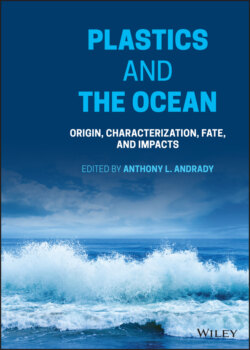Читать книгу Plastics and the Ocean - Группа авторов - Страница 49
2.3 Sources, Transport, and Fate of Additives in the Ocean
ОглавлениеDespite the growing concerns of plastic waste accumulation in the ocean, the environmental transport and fate of plastic additives are not well understood (Tian et al. 2020). Additives in plastics can be released from products into the air, water, and soil in all phases of the product life cycle and can be transported to the marine environment by numerous, interconnected, pathways (Figure 2.2).
Additives are well known to leach from plastics in the marine environment (De Frond et al. 2019; Koelmans et al. 2014; Paluselli et al. 2019; Pereao et al. 2020; Sun et al. 2019; Teuten et al. 2009). However, in addition to leaching, there are other sources of the same chemicals present in the ocean, some of which may even be more important, including direct industrial releases, wastewater effluents, atmospheric deposition, runoff, and river transport resulting from all human activities, including tire wear and application of sewage sludge in agriculture, resuspension from sediments, among other routes (Figure 2.2). For example, 14,742 metric tons of styrene were released into the environment from U.S. industries in 2019, independent from its leaching from plastic products, as reported to the U.S. Environmental Protection Agency’s Toxic Release Inventories (Table 2.4). Studies have shown that effluent from wastewater treatment plants and runoff, especially near plastic product manufacturing, as well as atmospheric deposition, are major sources of already leached plastic additives to aquatic environments (Kim et al. 2021; Liu et al. 2020; Peng et al. 2007; Staples et al. 1997; Zhang et al. 2013, 2018c).
Many discussions on movement of plastic additives within the ocean focus on the plastic itself as the main carrier but it is not the only significant transport mechanism (Zarfl and Matthies 2010). Koelmans et al. (2016) states that the fraction of hydrophobic organic compounds (HOCs), including organic additives, held by plastic is negligible compared to that held by other media (i.e. seawater, atmosphere, sediment, and biota), implying the plastic‐mediated transport to be generally unimportant in terms of HOC abundance.
The fate of plastic additives in the marine environment often differs from that of the plastic itself and is complicated (Figure 2.2). For example, additives that leach out of plastic can bioaccumulate in organisms or degrade, while the plastic itself might drift away. Alternatively, additives dissolved in water may be adsorbed by a different plastic particle that originally did not contain that chemical. Sorption and desorption of additives among multiple environmental compartments (plastic debris, water, sediment, air, and organic matter) are constantly and simultaneously happening through chemical equilibrium kinetics.
Figure 2.2 Complex sources and transport of plastic additives to, from, and within the ocean.
Table 2.4 Industrial releases of toxic plastic additives as reported to the U.S. EPA's Toxic Release Inventory in 2019.
Source: United States Environmental Protection Agency (2021). Toxic Release Inventory National Analysis 2019.
| Chemical name | Abbreviation | Additive class | Total onsite and offsite disposal (metric tons) |
|---|---|---|---|
| Styrene | — | Monomer | 14,742 |
| Nonylphenol | NP | Antioxidant/surfactant | 142 |
| Dimethyl phthalate | DMP | Plasticizer | 69 |
| Dibutyl phthalate | DBP | Plasticizer | 135 |
| PBBs | PBB | Flame retardant | 0.6 |
| Hexabromocyclododecane | HBCD | Flame retardant | 60 |
| Tetrabromobisphenol A | TBPPA | Flame retardant | 98 |
